
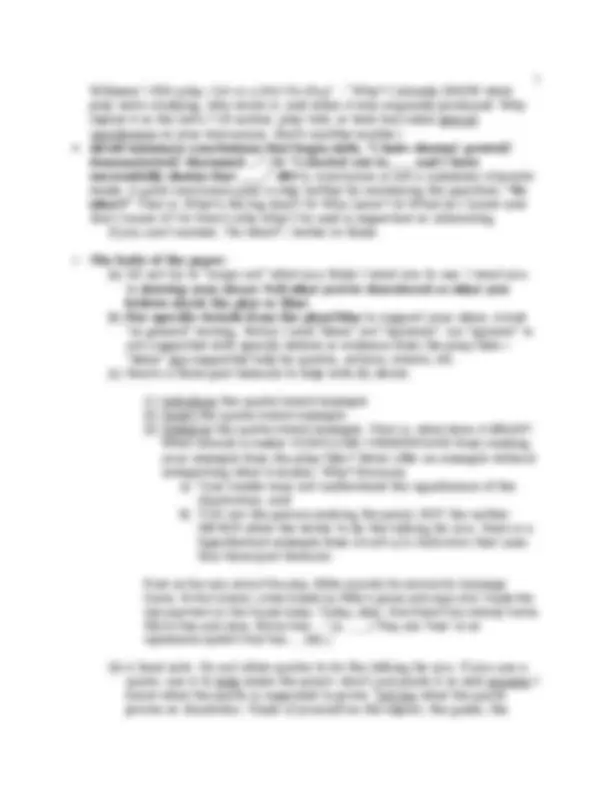
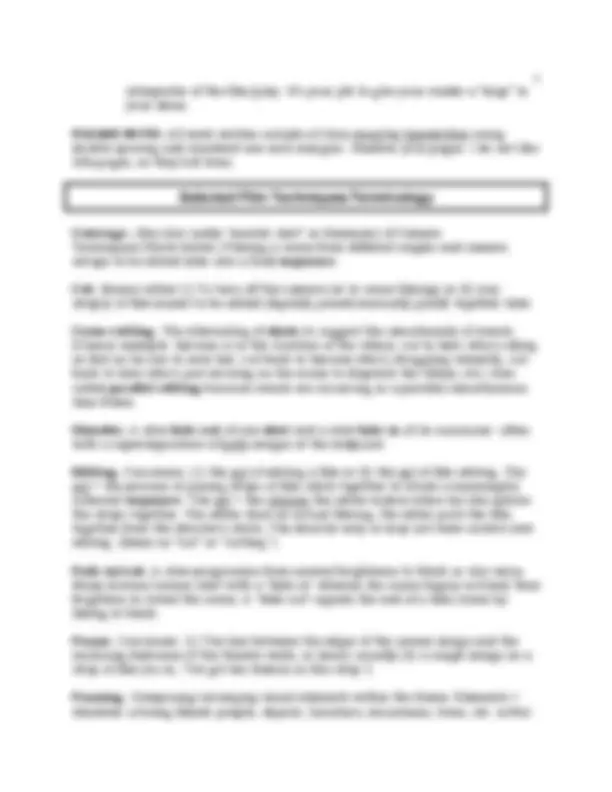

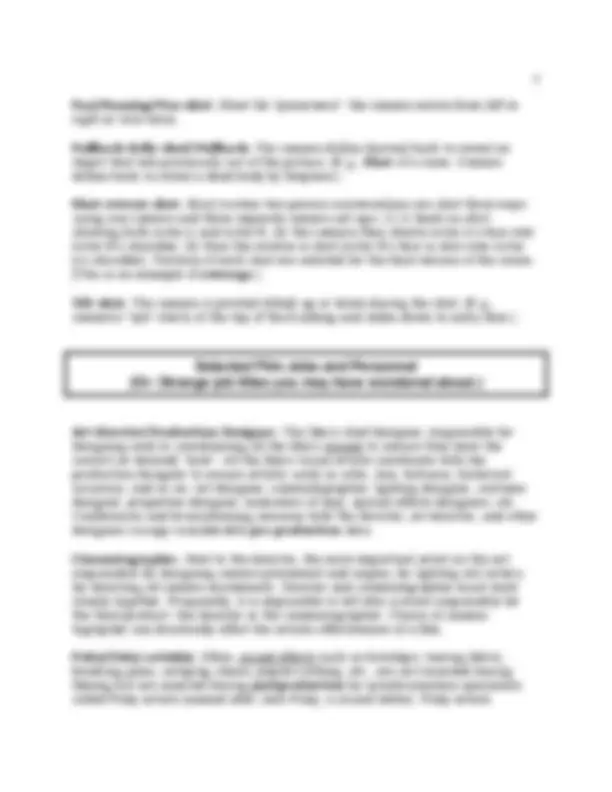
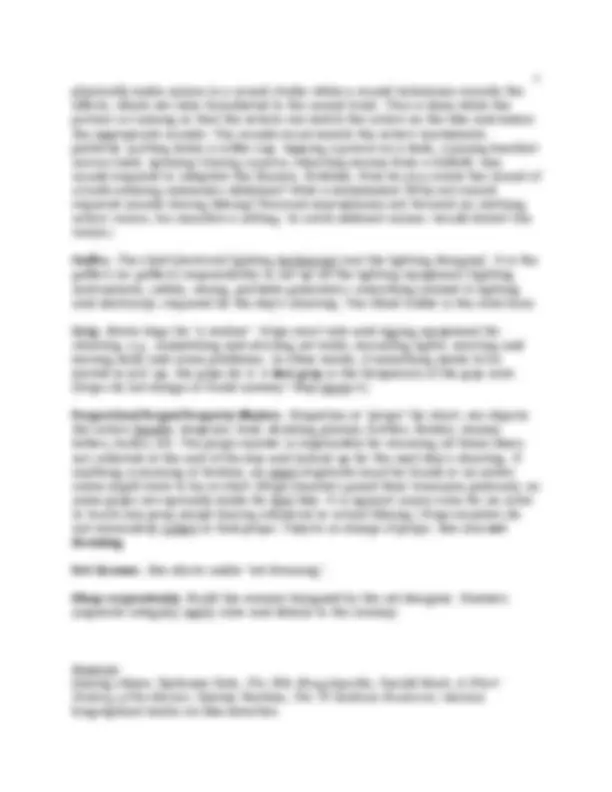
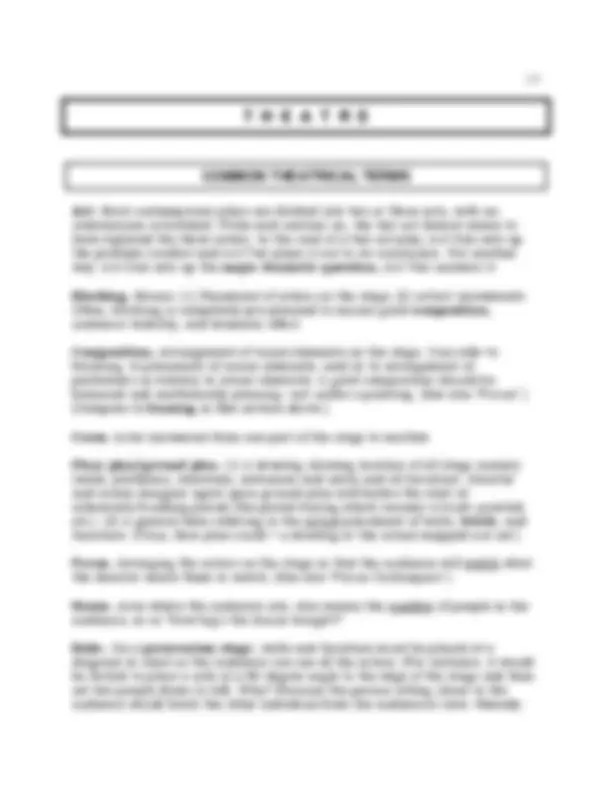
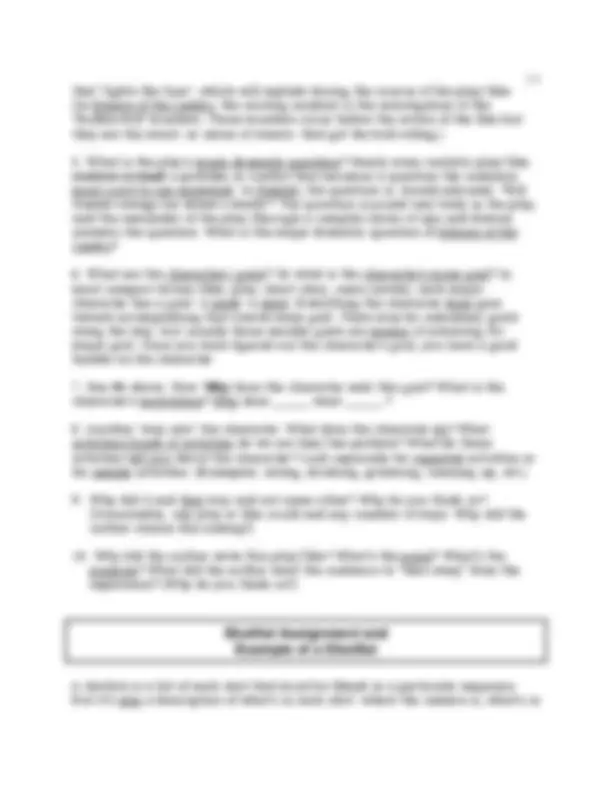
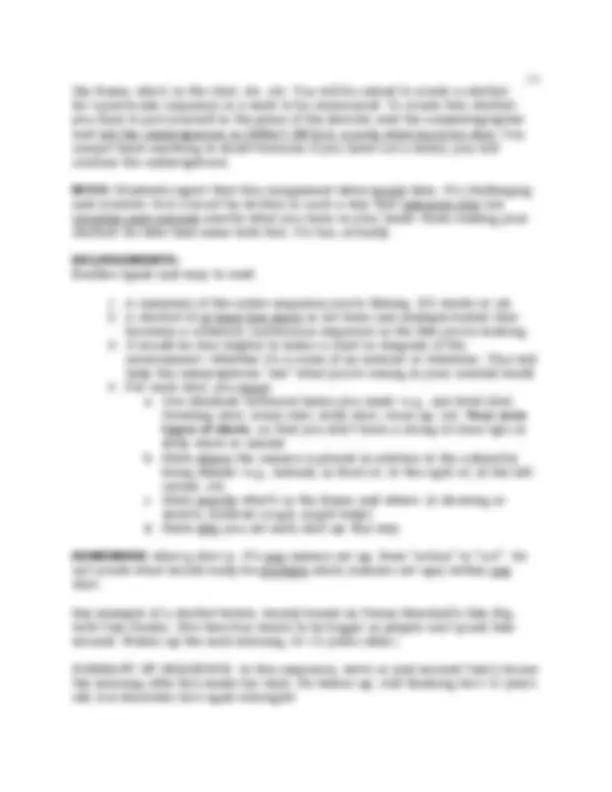

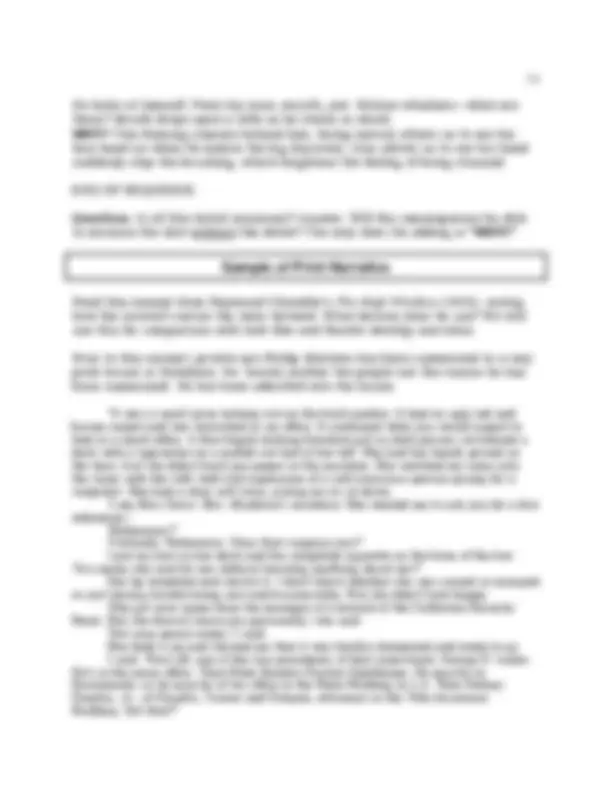
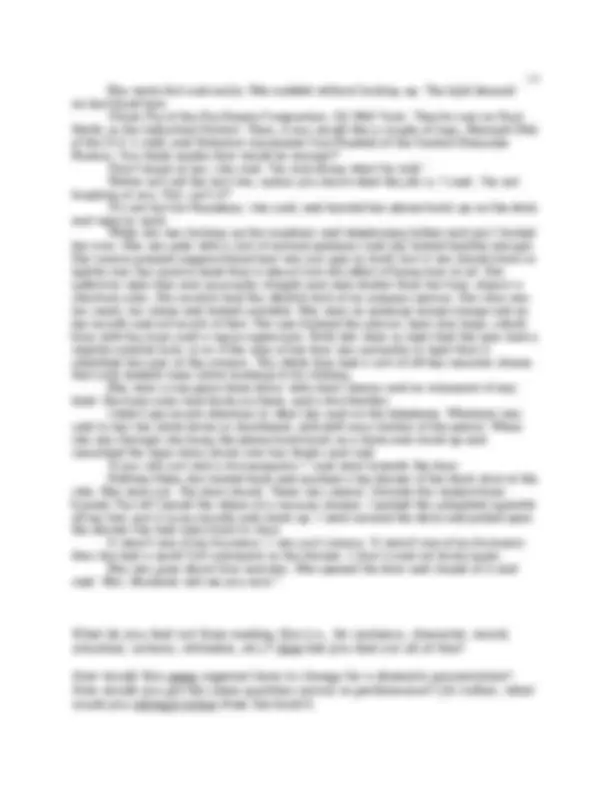



Study with the several resources on Docsity

Earn points by helping other students or get them with a premium plan


Prepare for your exams
Study with the several resources on Docsity

Earn points to download
Earn points by helping other students or get them with a premium plan
Community
Ask the community for help and clear up your study doubts
Discover the best universities in your country according to Docsity users
Free resources
Download our free guides on studying techniques, anxiety management strategies, and thesis advice from Docsity tutors
Material Type: Notes; Class: American Theatre on Film; Subject: Theatre Arts; University: Eastern Illinois University; Term: Unknown 1989;
Typology: Study notes
1 / 20

This page cannot be seen from the preview
Don't miss anything!













This study guide contains the following sections:
� How to Read a Play— Effectively ….page 1 � Writing a Paper for this Class…..page 2 � Film: o Selected Film Techniques/Terminology….page 4 o Summary of Camera Techniques/Shots….page 6 o Selected Film Jobs and Personnel…..page 8 � Theatre: o Common Theatrical Terms…..page 10 o Common Kinds of Theatrical Settings…..page 11 � Analysis Questions…..page 12 � Shotlist Project o (Example of how to write a shotlist)….. o Sample of print narrative—for comparison with film and theatre narrative. May also form the basis for the shotlist project. …..
Playscripts aren’t novels or magazine stories. They aren’t written to be read silently. They’re written to be SEEN in the theatre with live audiences responding to scenery, costuming, lights, and LIVING actors/characters caught up in some struggle. Since you aren’t seeing the stage version of some of the plays we’re reading, it’s very important that, while reading, you ENVISION the characters moving and speaking within a specific environment. If you’re not used to doing that, it’s not difficult! Here are some tips to smooth the path:
That way, the play will be more lively for you, and you’ll find it easier to follow. Imagine the people in a specific place. Move them about and PICTURE them behaving as you think they would in real life.
Yes, each instructor has his/her individual preferences and “tips”. Here are mine. They are not beastly—nor should they sound unfamiliar.
interpreter of the film/play. It’s your job to give your reader a “map” to your ideas.
PLEASE NOTE: All work written outside of class must be typewritten using double spacing and standard one-inch margins. Number your pages. I do not like title pages, as they kill trees.
Coverage. (See also under "master shot" in Summary of Camera Techniques/Shots below.) Filming a scene from different angles and camera setups to be edited later into a fluid sequence.
Cut. Means either (1) To turn off the camera (or to cease filming) or (2) Any strip(s) of film meant to be edited (digitally joined/manually glued) together later.
Cross-cutting. The alternating of shots to suggest the simultaneity of events. (Classic example: heroine is in the clutches of the villain; cut to hero who's riding as fast as he can to save her; cut back to heroine who's struggling valiantly; cut back to hero who's just arriving on the scene to dispatch the villain; etc.) Also called parallel editing because events are occurring in a parallel/simultaneous time frame.
Dissolve. A slow fade out of one shot and a slow fade in of its successor--often with a superimposition of both images at the midpoint.
Editing. Can mean: (1) the act of editing a film or (2) the art of film editing. The act = the process of joining strips of film shots together to create a meaningful, coherent sequence. The art = the choices the editor makes when he/she splices the strips together. The editor does no actual filming; the editor puts the film together from the director's shots. The director may or may not have control over editing. (Same as “cut” or “cutting”.)
Fade in/out. A slow progression from normal brightness to black or vice versa. Many movies/scenes start with a "fade in" wherein the scene begins in black then brightens to reveal the scene. A "fade out" signals the end of a film/scene by fading to black.
Frame. Can mean: (1) The line between the edges of the screen image and the enclosing darkness of the theatre walls, or (more usually) (2) a single image on a strip of film (As in, "I've got ten frames in this strip.").
Framing. Composing/arranging visual elements within the frame. Elements = whatever is being filmed: people, objects, furniture, mountains, trees, etc. Artful
framing can rise to the level of the best still photography or painting.
Loop/looping. Usually, dialogue is satisfactorily recorded during filming. But sometimes sound conditions are not ideal: echoes, loud footsteps, noise from traffic, wind, surf, etc.--all can drown out or distort dialogue. The situation has to be corrected in a sound studio through looping. For this, actors go to the studio, watch their filmed performance, and re-record the defective dialogue, synchronizing their words to their own lip movements. Everything must match exactly or the illusion is spoiled. Looping can take anywhere from a few hours to a few days (or weeks!), depending on conditions during filming.
Post-production period. The phase after all principal photography has ended and during which the film is put into final form. Includes looping , insertion of music and sound effects track, cutting and editing, and the addition of any computer-generated effects. For some of today's "blockbusters", it not unusual for the post-production period to take nearly as long as original filming.
Pre-production period. Period before actual filming begins during which director, producer, cinematographer, production designer, and other major contributing artists brainstorm ideas, discuss approaches, try to anticipate problems, and make all practical decisions concerning the making of the film: personnel, locations, travel, building schedule, materials (everything from fabric to nails) shooting schedule, special effects, stunts, budget, and so on. (Can also include script modifications/rewrites.)
Principal photography. Time period during which the major sequences are filmed (e.g., all scenes involving the major characters--including conversations, action scenes, closeups, etc.). A "second unit" may complete filming either later or at the same time (e.g., crowd scenes, shots of buildings, views of mountains, explosions, car chases, etc. Usually, none of these will involve the major characters.).
Sequence/scene. Sometimes used interchangeably. When I use the word “sequence,” I mean: A series of inter-related shots which, when edited together, form a coherent segment in the film. For example, in a sci-fi movie, separate shots showing an alien attack on the city will be edited together to form a sequence about HOW the city was turned into rubble. (e.g., alien ships approaching, people looking up in wonder, a ship blasting a building, people start running, another ship melts down a few cars, more people run, two ships converge on a skyscraper and blow it apart, etc.)
Set dressing. Fixtures, furniture, and decorations/objects attached to (or placed against or upon) the walls or floor of an interior set (chairs, lamps, table cloths, etc.). Also, items the set dressers add to an existing exterior location: for example, a park bench, a street light, a telephone booth, etc. Set dressing gives the look of
tracks—just like train tracks--are laid down on the set to gain smoother camera movement. (See also pullback dolly .)
Establishing shot. A shot or sequence at the beginning of a film or a scene that shows the audience where they are being taken: a city street, the mountains, a beach, etc. This clarifies the context of the following shots.
Eye-level shot. The camera is positioned so that audience and subject appear to be on the same level. (Also called a head-on shot .)
High-angle shot. The subject is photographed from above eye level. Sometimes used to diminish the power of the subject. (E.g., Actor A looking down from above on Actor B makes Actor A seem more powerful, dominant, or threatening.)
Long shot. Shot that shows the actors' entire body from the feet to the head. May also include foreground and considerable space above the actors' heads. For an extreme long shot , the camera may be (for example) a quarter of a mile away from the subjects.
Low-angle shot. The subject is photographed from below. Because the subject seems to tower above the viewer, low-angle shots are used to lend dominance to the subject--a person, a building, etc. Many of the creatures in Jurassic Park, Godzilla, etc. were photographed from a low angle to make them appear more menacing. (And to hide the technicians who were manipulating them.)
Master shot. A long shot (camera keeps rolling) during which all the action of the scene is filmed from one perspective. Into this, other coverage shots will be intercut for variety and dramatic interest. (Example: Long shot, low angle, of exhausted climbers five feet from the top of a mountain. Camera continues filming until characters reach the summit. Intercut for final version: Cut to tired face. Cut to hands grasping rocks. Cut to a foot nearly slipping. Cut back to long shot of climbers struggling. Cut to face sweating. Cut back to long shot of climbers. Cut to face seeing the top is nearly in sight. Cut to another face looking desperate. Cut back to long shot of climbers. Characters finally reach the top. Cut to looks of relief. The master shot was the long take of the actors climbing. The close ups were filmed at a different time and inserted into the sequence for dramatic interest.
Medium shot. A medium shot generally includes the body from about the waist up. Most TV news and shows are medium shots—Leno (or whoever) at the desk with guest in chair.
Over-the-shoulder shot. Widely used for two-person conversations: one actor's face is shot with the camera placed behind the other actor, catching the shoulder and the back of the listener's head. See also shot-reverse shot.
Pan/Panning/Pan shot. Short for "panorama": the camera moves from left to right or vice-versa.
Pullback dolly shot/Pullback. The camera dollies (moves) back to reveal an object that was previously out of the picture. (E.g., Shot of a room. Camera dollies back to reveal a dead body by fireplace.)
Shot-reverse shot. Most routine two-person conversations are shot three ways using one camera and three separate camera set-ups: (1) A head-on shot showing both Actor A and Actor B; (2) the camera then shoots Actor A's face over Actor B's shoulder; (3) then the reverse is shot (Actor B's face is shot over Actor A's shoulder). Portions of each shot are selected for the final version of the scene. (This is an example of coverage .)
Tilt shot. The camera is pivoted (tilted) up or down during the shot. (E.g., camera's "eye" starts at the top of the building and slides down to entry door.)
Art director/Production Designer. The film's chief designer, responsible for designing and/or coordinating all the film's visuals to ensure they have the correct (or desired) "look". All the film's visual artists coordinate with the production designer to ensure artistic unity in color, line, textures, historical accuracy, and so on: set designer, cinematographer, lighting designer, costume designer, properties designer, animators (if any), special effects designers, etc. Conferences and brainstorming sessions with the director, art director, and other designers occupy considerable pre-production time.
Cinematographer. Next to the director, the most important artist on the set: responsible for designing camera placement and angles; for lighting set/actors; for directing all camera movements. Director and cinematographer must work closely together. Frequently, it is impossible to tell who is more responsible for the final product--the director or the cinematographer. Choice of cinema- tographer can drastically affect the artistic effectiveness of a film.
Foley/foley artist(s). Often, sound effects such as footsteps, tearing fabric, breaking glass, scraping chairs, papers rattling, etc., are not recorded during filming but are inserted during postproduction by synchronization specialists called Foley artists (named after Jack Foley, a sound editor). Foley artists
Act. Most contemporary plays are divided into two or three acts, with an intermission in between. From mid-century on, the two-act format seems to have replaced the three-acters. In the case of a two-act play, Act One sets up the problem/conflict and Act Two plays it out to its conclusion. Put another way: Act One sets up the major dramatic question , Act Two answers it.
Blocking. Means: (1) Placement of actors on the stage; (2) actors' movements. Often, blocking is completely pre-planned to ensure good composition , audience visibility, and dramatic effect.
Composition. Arrangement of visual elements on the stage. Can refer to blocking, to placement of scenic elements, and/or to arrangement of performers in relation to scenic elements. A good composition should be balanced and aesthetically pleasing--not unlike a painting. (See also "Focus".) [Compare to framing in film section above.]
Cross. Actor movement from one part of the stage to another.
Floor plan/ground plan. (1) A drawing showing location of all stage scenery (walls, platforms, stairways, entrances and exits) and all furniture. Director and scenic designer agree upon ground plan well before the start of rehearsals/building period (the period during which scenery is built, painted, etc.). (2) A general term referring to the actual placement of walls, levels , and furniture. (Thus, floor plan could = a drawing or the actual mapped-out set.)
Focus. Arranging the actors on the stage so that the audience will watch what the director wants them to watch. (See also "Focus Techniques".)
House. Area where the audience sits; also means the number of people in the audience, as in "How big's the house tonight?"
Rake. On a proscenium stage , walls and furniture must be placed at a diagonal or slant so the audience can see all the action. (For instance, it would be foolish to place a sofa at a 90-degree angle to the edge of the stage and then set two people down to talk. Why? Because the person sitting closer to the audience would block the other individual from the audience's view. Remedy:
place the sofa at a diagonal so that both actors are open to the audience's view.) Although this seems unnatural, it is necessary for audience sightlines-- and most audiences do not notice the artificiality.
Scene. A significant "chunk" of action within an act. The scene is the building block of any play. All scenes center around an important action. The opening scene of any play, for instance, is the expository scene, during which the exposition is given. Exposition = introducing the major characters, giving the background, and getting the story going. The climactic scene (usually close to the end) is that scene when characters/forces meet in a "showdown" and someone or something wins out or some problem is solved.
Stage directions. In the published version of a pre-existing (as opposed to a new) play, editors may include detailed descriptions of what actors do as they say the lines. (E.g., "Crosses to the fireplace and sits angrily" or "Smiles sweetly" or "Looks out the window, sadly" or similar.) Seldom do playwrights write these directions; usually, the directions are either (a) inserted by editors to make the play more vivid for readers or (b) the directions are a record of what the original actors did in the original production. Directors of subsequent versions of the play feel free to ignore most stage directions--except for such directions as "Exit", "Enter", "Dies", and similar.
Staging. (1) General term referring to the act of transferring a printed script to the live theatre. Includes scenic and other visual elements and actors' blocking. Another way of putting it: "bringing the play to life". (2) Can also refer to the director's approach or his/her choices.
Arena stage/Arena. Theatre in which the audience sits on four sides, surrounding the actors and scenery: theatre in the round.
Box set. Set that has four walls and (sometimes) a visible ceiling. Doors and windows are workable. Purpose of any box set is to create the look and feel of daily life/reality.
Non realism. Can mean many things, but for our purposes: Approach to set design wherein either (a) The lines and/or colors of a set may be warped or distorted--to suggest/support the idea of the characters' inner turmoil. (b) There is no set, as such; the same space is used for many locations. Furnishings are "generic": a table, a chair, a bench, or solid cubes the actors use as furniture. (Sometimes this is called a "minimalistic" approach--because setting is minimal.)
that "lights the fuse", which will explode during the course of the play/film. (In Silence of the Lambs, the inciting incident is the investigation of the "Buffalo Bill" murders. Those murders occur before the action of the film but they are the event--or series of events--that get the ball rolling.)
A shotlist is a list of each shot that must be filmed in a particular sequence. But it’s also a description of what’s in each shot: where the camera is, what’s in
the frame, who’s in the shot, etc. etc. You will be asked to create a shotlist for a particular sequence in a work to be announced. To create this shotlist, you have to put yourself in the place of the director and the cinematographer and tell the cameraperson in GREAT DETAIL exactly what must be shot. You cannot leave anything to doubt because if you leave out a detail, you will confuse the cameraperson.
NOTE: Students report that this assignment takes much time. It’s challenging and creative—but it must be written in such a way that someone else can visualize and recreate exactly what you have in your head—from reading your shotlist! So take time some with this. It’s fun, actually.
REQUIREMENTS: Besides typed and easy to read:
REMEMBER what a shot is. It’s one camera set up, from “action” to “cut”. Do not create what would really be multiple shots (camera set-ups) within one shot.
See example of a shotlist below, loosely based on Penny Marshall’s film Big , with Tom Hanks. (Pre-teen boy wants to be bigger so people can't push him around. Wakes up the next morning 10-15 years older.)
SUMMARY OF SEQUENCE: In this sequence, we’re in and around Tom’s house the morning after he’s made his wish. He wakes up, still thinking he’s 12 years old, but discovers he’s aged overnight!
sleeping dog. Camera pans from left to right showing us the room. Ends up again— panning left —directly in front of the bed. Camera dollies forward two feet or so and tilts upward to focus on the top rack of the bed. The lump on top of the bed moves a bit. Tom is resisting waking up; he’s still burrowed under the quilt. WHY? The visuals and camera moves show us Tom is an average messy kid, likes sports and movies and other “boy stuff”. He has an All-American dog. He doesn’t want to get out of bed.
Mom calls again. Camera cuts to:
SHOT # Close-up, eye-level shot of head under the quilt. Camera is level with Tom’s head, so we see the upper part of the mattress Tom is on. Quilt moves slightly and we see the top of a head and a closed eye emerge. Tom grunts in response to Mom’s call. Mom calls again. Tom grunts again. He starts to throw the quilt off and sit up. All we see is the arm starting to throw the quilt off, and the camera cuts to next shot. WHY? To show us he’s still three-quarters asleep, to show us he’s finally getting up. Also, we don’t want to see him fully yet because the last time we saw him he was 12 years old.
SHOT # Tom has sat up, quilt thrown off and at the foot of the bed, frame left. Medium shot, eye-level with the lower part of the top rack of the bunk. All we see is of him is two hairy legs from the knees down to the feet—dangling over the side of the bed. They don’t look like a kid’s legs and feet! We don’t see the rest of Tom. WHY? We need to see he’s getting up; we still don’t want to show his size yet.
Mom calls again—a little grouchy this time. The legs and knees start to scoot forward off the side of the bed. Camera cuts to:
SHOT #
Slight high-angle shot , with camera focused about a foot above floor level, shooting down at a close-up of two hairy adult feet hitting the floor. Toes wiggle. All we see are his feet and ankles. Also in frame: a bit of floor, rug. We hear Tom yawn. WHY? To show he’s out of bed, to tantalize audience a little more with signs that he’s changed. Camera cuts to:
SHOT #
Cut to left of bed, camera still at slight high-angle just above floor level.
Close-up of dog in left of frame. Dog looks up at to frame right, as if at Tom. We see most of the dog, with some of the lower part of the bed in the right of the frame. Dog stares. Then we see the left side of two adult feet and legs (below the knee) as they walk past the dog—from frame right toward frame left. Dogs head and eyes follow the feet as they walk past him and out of the left side of the frame. WHY? To show the dog is not used to seeing this person; to show Tom is finally out of bed and headed somewhere. Camera cuts to:
SHOT #
Follow shot with camera behind Tom and about 18 inches above floor level. We still see only his feet and lower legs as he stumbles slowly down the hall. (Floor is bare wood, as in Tom’s room.) Need to see part of the wall in the frame so it doesn’t look like he’s on a ramp or isolated in space. Mom calls again. Tom answers, “I’m up.” As feet move out of top of the frame, the dog ( Close-up of back of head only) wanders into lower part of the frame, still staring up at this stranger. Camera cuts to next shot. WHY? To follow Tom down the hall; to show the dog is still puzzled; to make the audience ask when Tom will find out he’s changed.
SHOT #
Camera is at the bathroom door looking inside. Eye-level medium long shot of Tom from the back. He’s in front of a lavatory and bathroom mirror, eyes still half shut. We see most of him and portions of lavatory and mirror. Mechanically, he smears toothpaste on toothbrush, looking down at the sink-- so he doesn’t see himself in the mirror—which is right in front of him. To his left are towels on a wall rack, to his right a shower curtain. WHY? We need to know where he went, and we need to see he’s just about to make the big discovery! Still looking down at lavatory, Tom begins to brush teeth, bending over the sink, brushing mechanically. Camera cuts to:
SHOT #
Eye-level medium shot from the same perspective, but closer to Tom. We see him from mid-back to top of head. He’s still bent over, brushing teeth. We see the mirror, which is just to right of center of the frame.
Still brushing, Tom straightens up, looks blearily into mirror. Sees himself. Freezes—eyes wide. He’s made the discovery! (We see his face in the mirror and also his back and the back of his head—so we’re seeing the top half of his body.)
She wrote fast and easily. She nodded without looking up. The light danced on her blond hair. ‘Oliver Fry of the Fry-Krantz Corporation, Oil Well Tools. They’re over on East Ninth, in the Industrial District. Then, if you would like a couple of cops, Bernard Ohls of the D.A.’s staff, and Detective-Lieutenant Carl Randall of the Central Homicide Bureau. You think maybe that would be enough?’ ‘Don’t laugh at me,’ she said. ‘I’m only doing what I’m told.’ ‘Better not call the last two, unless you know what the job is,’ I said. ‘I’m not laughing at you. Hot, isn’t it?’ ‘It’s not hot for Pasadena,’ she said, and hoisted her phone book up on the desk and went to work. While she was looking up the numbers and telephoning hither and yon I looked her over. She was pale with a sort of natural paleness and she looked healthy enough. Her coarse-grained coppery blond hair was not ugly in itself, but it was drawn back so tightly over her narrow head that it almost lost the effect of being hair at all. Her eyebrows were thin and unusually straight and were darker than her hair, almost a chestnut color. Her nostrils had the whitish look of an anaemic person. Her chin was too small, too sharp and looked unstable. She wore no makeup except orange-red on her mouth and not much of that. Her eyes behind the glasses were very large, cobalt blue with big irises and a vague expression. Both lids were so tight that the eyes had a slightly oriental look, or as if the skin of her face was naturally so tight that it stretched her eyes at the corners. The whole face had a sort of off-key neurotic charm that only needed some clever makeup to be striking. She wore a one-piece linen dress with short sleeves and no ornament of any kind. Her bare arms had down on them, and a few freckles. I didn’t pay much attention to what she said on the telephone. Whatever was said to her she wrote down in shorthand, with deft easy strokes of the pencil. When she was through she hung the phone book back on a hook and stood up and smoothed the linen dress down over her thighs and said: ‘If you will just wait a few moments—‘ and went towards the door. Halfway there she turned back and pushed a top drawer of her desk shut at the side. She went out. The door closed. There was silence. Outside the window bees buzzed. Far off I heard the whine of a vacuum cleaner. I picked the unlighted cigarette off my hat, put it in my mouth and stood up. I went around the desk and pulled open the drawer she had come back to shut. It wasn’t any of my business. I was just curious. It wasn’t any of my business that she had a small Colt automatic in the drawer. I shut it and sat down again. She was gone about four minutes. She opened the door and stayed at it and said: ‘Mrs. Murdock will see you now.’”
What do you find out from reading this (i.e., for instance, character, mood, situation, actions, attitudes, etc.)? How did you find out all of this?
How would this same segment have to change for a dramatic presentation? How would you get the same qualities across in performance? (Or rather, what could you salvage/retain from the book?)
Further yet, how would it change from stage to screen or vice-versa? What kinds of differences might you perceive in a live stage rendition and a film rendition of the same segment?